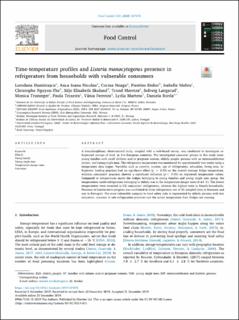Time-temperature profiles and Listeria monocytogenes presence in refrigerators from households with vulnerable consumers
| dc.contributor.author | Dumitrașcu, Loredana | |
| dc.contributor.author | Nicolau, Anca Ioana | |
| dc.contributor.author | Neagu, Corina | |
| dc.contributor.author | Didier, Pierrine | |
| dc.contributor.author | Maître, Isabelle | |
| dc.contributor.author | Nguyen-The, Christophe | |
| dc.contributor.author | Skuland, Silje Elisabeth | |
| dc.contributor.author | Møretrø, Trond | |
| dc.contributor.author | Langsrud, Solveig | |
| dc.contributor.author | Truninger, Monica | |
| dc.contributor.author | Teixeira, Paula | |
| dc.contributor.author | Ferreira, Vânia | |
| dc.contributor.author | Martens, Lydia | |
| dc.contributor.author | Borda, Daniela | |
| dc.date.accessioned | 2021-01-11T12:11:26Z | |
| dc.date.available | 2021-01-11T12:11:26Z | |
| dc.date.created | 2020-07-27T12:09:32Z | |
| dc.date.issued | 2020 | |
| dc.identifier.citation | Food Control. 2020, 111 . | |
| dc.identifier.issn | 0956-7135 | |
| dc.identifier.uri | https://hdl.handle.net/11250/2722369 | |
| dc.description.abstract | A transdisciplinary observational study, coupled with a web-based survey, was conducted to investigate refrigerated storage of food, in five European countries. The investigated consumer groups in this study were: young families with small children and/or pregnant women, elderly people, persons with an immunodeficient system, and young single men. The refrigerator temperature was monitored for approximately two weeks using a temperature data logger. Variables such as country, income, age of refrigerators, education, living area, refrigerator loading practices had no significant effect (p > 0.05) on the overall average fridge temperature, whereas consumers' practices showed a significant influence (p < 0.05) on registered temperature values. Compared to temperatures inside the fridges belonging to young families and young single men group, the temperatures inside refrigerators belonging to elderly was in the temperature danger zone (5–63 °C). The lowest temperatures were recorded in UK consumers’ refrigerators, whereas the highest were in French households. Presence of Listeria monocytogenes was confirmed in three refrigerators out of 53 sampled (two in Romania and one in Portugal). The most vulnerable category to food safety risks is represented by elderly persons with low education, unaware of safe refrigeration practices and the actual temperature their fridges are running. | |
| dc.language.iso | eng | |
| dc.subject | Young family | |
| dc.subject | Young family | |
| dc.subject | Elderly | |
| dc.subject | Elderly | |
| dc.subject | Young single men | |
| dc.subject | Young single men | |
| dc.title | Time-temperature profiles and Listeria monocytogenes presence in refrigerators from households with vulnerable consumers | |
| dc.type | Peer reviewed | |
| dc.type | Journal article | |
| dc.description.version | publishedVersion | |
| dc.source.pagenumber | 0 | |
| dc.source.volume | 111 | |
| dc.source.journal | Food Control | |
| dc.identifier.doi | 10.1016/j.foodcont.2019.107078 | |
| dc.identifier.cristin | 1820595 | |
| dc.relation.project | EC/H2020/NO727580 | |
| dc.relation.project | Nofima AS: 11897 | |
| dc.relation.project | EC/H2020/727580 | |
| cristin.ispublished | true | |
| cristin.fulltext | original | |
| cristin.qualitycode | 1 |
Tilhørende fil(er)
Denne innførselen finnes i følgende samling(er)
-
Artikler / Articles [1429]
-
Publikasjoner fra CRIStin [2492]
